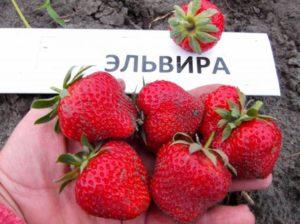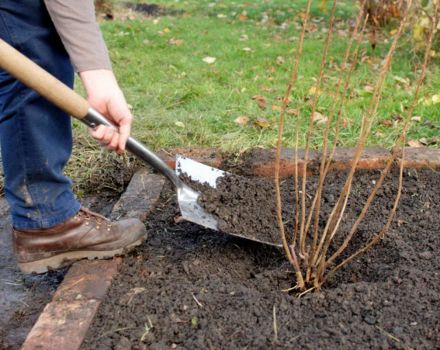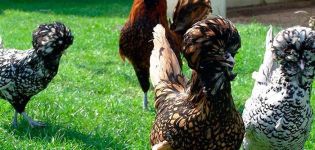Nuances of strawberry propagation by dividing the bush, transplant rules in August
3-4 years after planting, the strawberry bush thickens. Many horns grow on it, which begin to compete for sunlight and food. The yield goes down. The situation can be corrected by multiplying strawberries by dividing the bush in August. Further information on how to properly perform the procedure on the garden plot, as well as the typical mistakes made by farmers.
Advantages and disadvantages of the method
Propagation of strawberries by dividing an old bush has the following advantages:
- simplicity and availability of the method;
- good survival rate of bushes;
- the possibility of harvesting from the mother plant in the current year;
- fruiting of young bushes begins in the next season;
- yield increases;
- the new plants retain their parental characteristics.
Many gardeners prefer to breed remontant strawberries as they yield twice a year. But some varieties do not form the whiskers that the strawberries use to reproduce quickly. Therefore, dividing the bush is the only way to breed it. There were no drawbacks to the method.
Additional Information. 110 grams of strawberry berries contain the daily dose of vitamin C.
When is the best time to do it?
The sooner the bush is divided and transplanted, the faster the young horns will take root in a new place. If the procedure is performed in the fall, there is a possibility of freezing strawberries in the harsh winter. And even if it survives, it may not yield a crop.
Therefore, it is best to replant garden strawberries in summer or early autumn. The bushes planted in August have time to take root, adapt to new conditions before the onset of frost. You need to plant only healthy, without signs of disease and pests, plants.
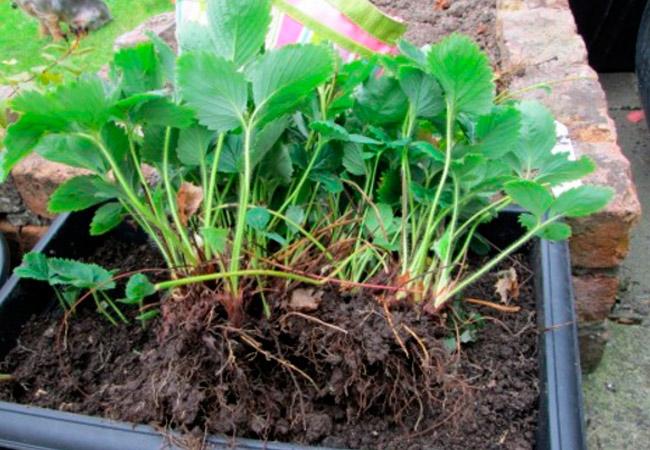
How to propagate strawberries by dividing a bush
With the correct procedure, fruiting will begin as early as next season. The place is chosen sunny, well-ventilated. The landing method is chosen as one-line or two-line. The latter method allows you to save territory. Divided sockets are planted at a distance of 25 centimeters from each other.
Selection of mother bushes
Experienced gardeners have beds with strawberry bushes of different ages. You can propagate 2-4-year-old plants. The more mature the culture, the more young horns grow on it. It makes no sense to keep plants older than 4 years in the garden, since the berries become smaller, the yield decreases.
Healthy bushes are chosen for reproduction. They should not be affected by diseases and pests. In spring or early summer, pegs can be driven in near the most fruiting plants. In August, they begin to transplant them.
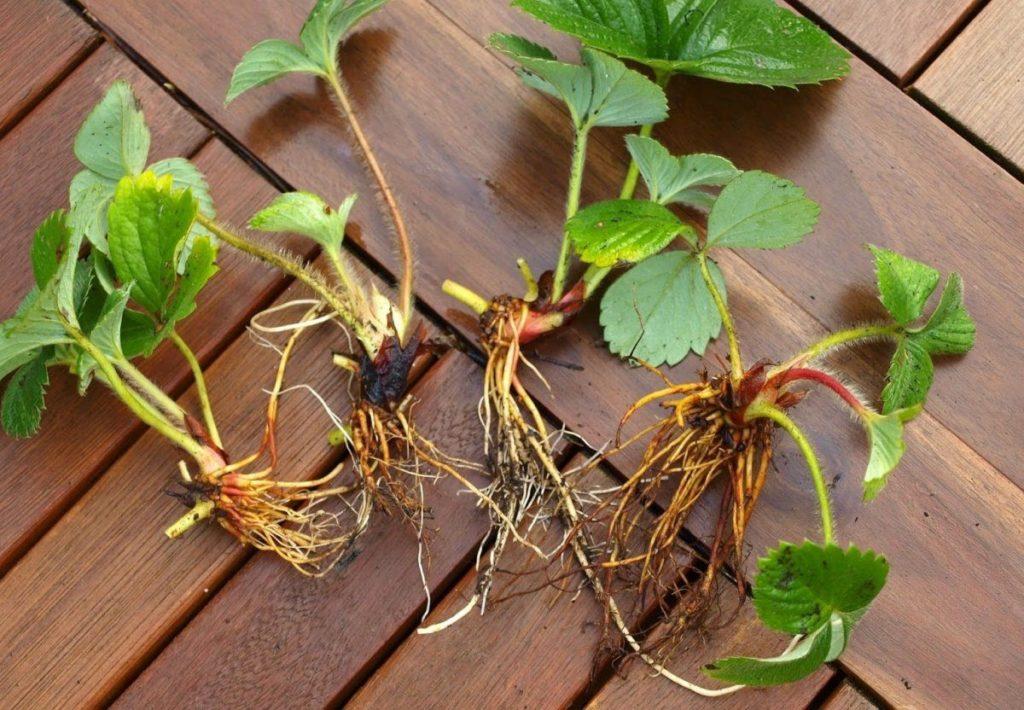
How to divide correctly?
The selected bushes are divided as follows:
- dipped strawberries on all sides with a sharp shovel;
- the roots are shaken off the ground, yellow and dry leaves are removed;
- the root system is placed in a container filled with a solution of potassium permanganate;
- each horn is carefully manually separated from the mother plant;
- the damaged parts are cut off, sprinkled with wood ash for disinfection.
It happens that 2 horns grow on one root. You can cut it in half with a sharp knife and plant each bush separately.
Important! To prevent the ingress of pathogenic microorganisms on the horns, the cut parts are treated with antifungal drugs. The root system can be placed in a potassium permanganate solution for 30-40 minutes.
Planting horns for growing
If there were many small horns with a small root system on the bush, they are grown. For this, small pots are selected, preferably peat pots.
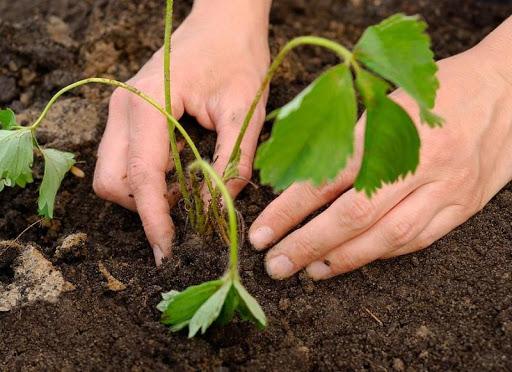
The transplant is done like this:
- ⅔ containers are filled with a substrate consisting of garden soil and peat;
- a horn is placed in the center;
- cover the earth along the root collar;
- watered abundantly;
- cover the pots with foil or bring them into the greenhouse.
You can plant the horns in a permanent place after 1-1.5 months. The disadvantage of this method is that the bushes will hurt when planted in open ground. If the horns are planted in peat pots, the further procedure will be less painful. In this case, the bushes do not need to be shaken out: they are planted with containers.
Further care
Strawberry care consists in timely watering, loosening the soil, cleaning plant residues from the garden.

Watering
The bushes are watered abundantly when planting. Then the amount of moisture introduced will depend on the rainfall. In dry weather, the land is often irrigated, since strawberries are a moisture-loving crop. In this case, you need to ensure that no stagnation of water is created at the roots. Excessive moisture contributes to the formation of fungal diseases.
Note! In order for garden strawberries to safely endure winter frosts, in the middle of autumn they are watered abundantly with water.
Top dressing
Fertilize strawberries during a spring transplant. Complex mineral compositions are used. During flowering, foliar irrigation with nutrients can be carried out. With a late summer or autumn transplant, top dressing is not performed.

Loosening
1-2 days after watering, the soil around the plants is loosened. This removes weeds that interfere with the development of strawberries. The procedure prevents the formation of a crust on the surface of the soil. Loosening promotes the access of air to the depth of the ground. The work is performed carefully, since garden strawberries have a superficial root system.
Protection against diseases and pests
For prevention, plants are treated with special preparations, according to the instructions on the package. The yellow, dry leaves are cut off. Plant debris is removed from the root circle, since pathogenic microorganisms and insect larvae can winter in them.
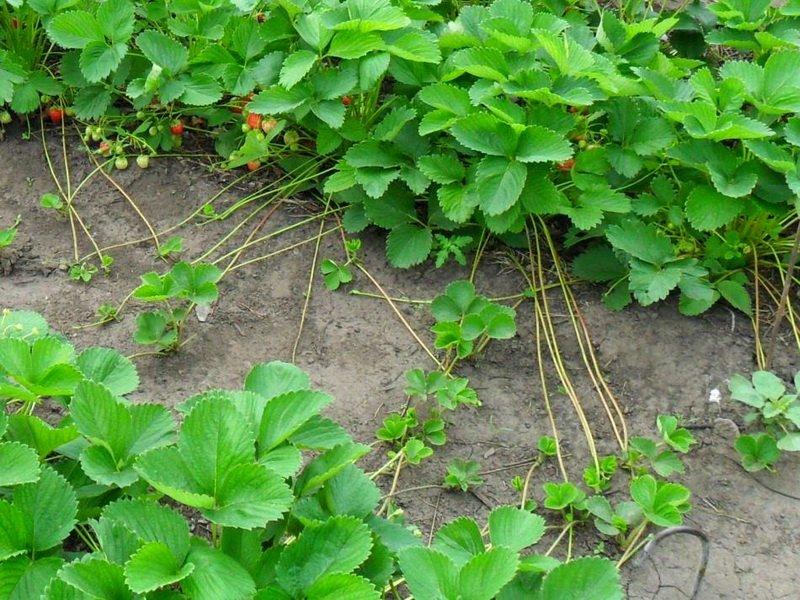
Typical mistakes
Inexperienced gardeners make mistakes when transplanting strawberries. As a result, the culture is sick, does not bear fruit, or completely disappears. Typical errors are as follows:
- Failure to comply with crop rotation. Strawberries do not develop well in the area where nightshade crops grew. Root secretions remain in the ground, depressing garden strawberries. The best predecessors are legumes, carrots, radishes, herbs, onions, garlic.
- Late transplant. The culture must be planted in the ground at least a month before the onset of cold weather. Otherwise, it may freeze in winter.
- Abundant nitrogen application.The nutrient promotes the development of the green part of plants. Excess nitrogen in the soil prevents flowering and fruiting of the crop.
- Frequent watering. Strawberries are hygrophilous. But, if the land between waterings does not have time to dry out, the root system may undergo fungal diseases.
- Bushes are planted too deep. The root collar of garden strawberries should be on the surface of the soil. When deepened, the culture may not begin to bear fruit.
- Deep loosening of the soil is carried out. The root system of strawberries is superficial. Deep loosening can damage the roots.
- For the winter, the bushes are covered with foil. Under a non-breathable covering material, bushes can blow out. On the eve of a harsh winter, the plants are covered with spruce branches, agrofibre.
Breeding strawberries in August is a simple but responsible process. Observing all the rules of planting and care, the gardener will enjoy a tasty, healthy berry next season.

